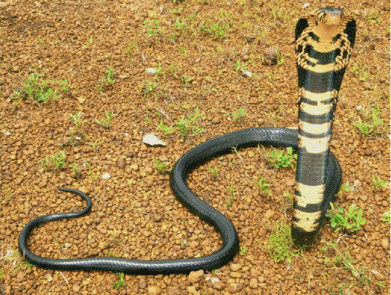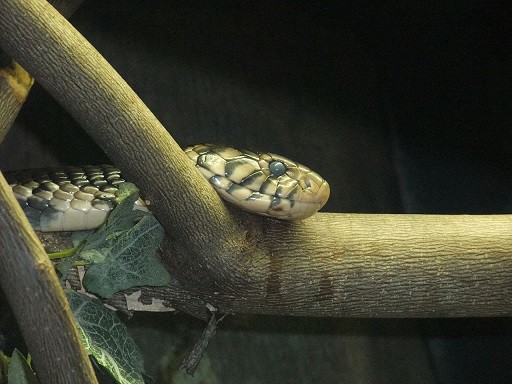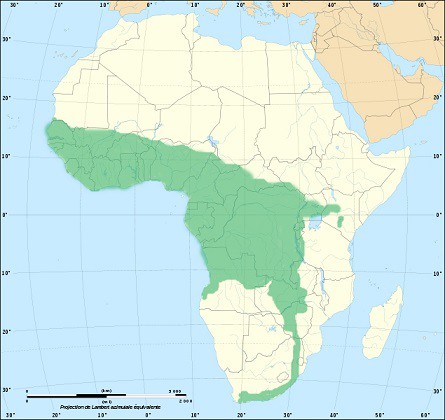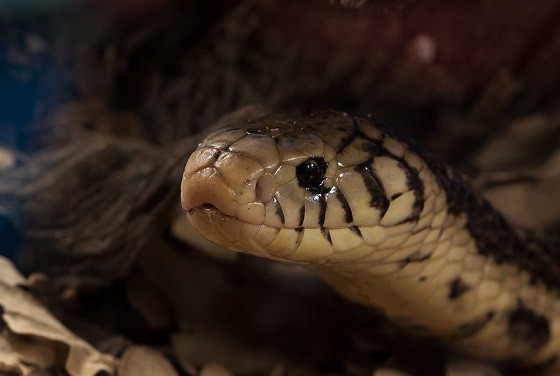| 1 | The longest true cobra |

In Western countries, the main danger of visiting a thick forest at high altitude is getting lost and having to spend a night exposed to elements, possibly with a hungry grizzly bear on your trail. In Africa, high altitude forests have much different set of dangers. Rainforests are one thing – you’d expect them to be crawling with danger – but even regular forests are home to a 2 metre long serpent with a corrosive venom, venom which has been bubbling away in the forges of evolution for approximately 25 million years.
We’re talking, of course, about the forest cobra (Naja melanoleuca), a version with deep, liquorice grey scales that gradually lighten towards beige as the neck approaches. This is the largest true cobra in the world, averaging at 140-220cm, with an all time record of 320cm.
The forest cobra easily outstrips the fearsome cape cobra (120-140cm) of South Africa, or the notorious Chinese cobra (120-150cm). Males and females are equal in length, and hatchlings are born at an average of 22.5cm.
The patterns are very uneven with this snake, as the beige sections look like paint flaking off a wall, or a pale scarf wrapped around a liquorice body multiple times. Like other cobras, Naja melanoleuca is a multi-skilled snake, which generally sticks to the ground, but is excellent at climbing trees and swimming across lakes when the occasion arises.
| 2 | Monstrous venom, yet rarely kills |

Among the 30-strong true cobra genus (Naja), the forest cobra ranks a respectable fourth in venom toxicity. The LD50 rating is 0.225mg, beaten only by the Samar cobra (0.21mg), the Philippine cobra (0.14mg), and the dreaded Caspian cobra (0.10mg).
The venom yield is also a colossal 571mg, compared to the Indian cobra at 169-250mg, thanks to the species’ huge hollow fans. It’s almost impossible to miss these liquorice-grey cobras on the forest floor, and their camouflage is relatively weak, but their ninja-like reaction times more than make up for any deficiencies, as do their huge strike distances.
The venom is mostly neurotoxic, and largely consists of three finger toxins (57.1% of total toxins). These lead to muscle weakness and drooping, and possibly death via lung failure, via a total inability of the brain to control organs.
Despite those worrying facts, the forest cobra has an extremely low death toll per year, so low in fact that its venom was largely unresearched until 2017. The poor camouflage is one reason, as is their tendency to forage rather than lie for weeks at a time preparing for ambush.
| 3 | Habitat: forests and fruit plantations |

Compared to some snakes, the forest cobra is extremely adaptable. It might prefer forests, but it also dwells in agricultural fields, rocky plains, dry parched savannah. The main place you won’t find forest cobras is true deserts like the Sahara. Their altitude requirements are equally flexible, with sightings ranging from 0 metres above sea level to 2400m. Their main agricultural hideout is said to be fruit plantations, where they cling to the trees. Forest cobras are also handy in urban areas, and may be infiltrating towns in ever higher numbers now that their forests are being cut down.
No wonder then, that they are classified as “least concern” by IUCN, and are spread far and wide over Africa. It’s a similar story of flexibility with their diet. The forest cobra is a non-fussy snake which can derive nutrition from rats, amphibians, birds, fish, and small lizards to equal effect. It’s said to prefer frogs if available, but with large gaps in the record, nobody is fully certain.
| 4 | Lifespan: up to 35 years |
Another power this serpent wields is living for an extremely long time. Big snakes generally live longer (unlike cats versus dogs), but the forest cobra holds a record of 35 years in captivity. This particular snake lived in a Melbourne zoo and hit the 35 year milestone on September 1st 2014. His name was Cosby, and he was 2.4 metres long, having grown 1mm per year since reaching adulthood like all forest cobras.
The zookeepers claimed that his personality was relaxed, with a “cruisy” attitude. He was a true homebody who normally returned to his sanctuary of his own accord, after his regular exercise sessions. The only problem was that Cosby was in torpor due to the Australian winter, and didn’t get the chance to eat his birthday treats.
Consequently, the forest cobra is the current record holder for longest lived venomous snake in captivity, as the non-venomous ball python has reached 60 years before. Its lifespan in the wild is thought to reach 20 years quite commonly. It’s perfectly conceivable that a man could venture into the forest to show his son the cobra that bit him ten years earlier – if he could find it.
| 5 | A rare fish-eating snake |

The forest cobra has a massive range, stretching all the way from the Atlantic coast in Senegal and Mauritania, to its easternmost point in central Kenya. There’s also a thin finger of range extending southwards towards South Africa, but skipping Namibia to the west. The forest cobra is common in all the smaller West Africa countries such as Ghana, Togo, Benin, Liberia and the Ivory Coast.
Consequently, the forest cobra has a massively varied diet, as it adapts to ever varying environments. In some areas, they even eat fish as a regular staple, which is extremely rare for a land-dwelling snake.
In 1996, biologist Luca Luiselli was observing a muddy pond surrounded by mangroves in the Niger Delta of Nigeria, not far from the country’s fifth largest city, Port Harcourt. He watched as a small juvenile forest cobra measuring 63.2cm spent 15 minute circling the edges of a pond, in a determined effort to catch the fish within. It managed to apprehend two, and swallowed them immediately afterwards, barely using its potent venom. The fish were mudskippers (Periophthalmus), semi-land dwelling fish that are highly aggressive and territorial.
| 6 | Grabs birds from mid-air |
Similar tales have been witnessed with the forest cobra and birds in the sky. In February 2009, biologist Jonathan Warner was examining snakes near the small coastal village of St Lucia in north-eastern South Africa. Forest cobras were notoriously common near this village, and Warner noticed how it was dead simple to deduce their presence, because the nearby birds would always let out shrieking calls of alarm.
One of those birds was the white-eared barbet, and Warner noticed how this species often swooped down at the forest cobra and struck it with mock attacks. The goal was probably to scare the snake into submission, but the forest cobra often snapped back in a vicious response.
One day, Warner spotted a forest cobra resting on a tree branch 2 meters above ground, and sliced its stomach open. Out rolled a barely-digested white-eared barbet. Then came 5 more, and together, the six birds weighed 261 grams, 36.7% of the snake’s total body weight. This bird species nests in alcoves on tree trunks, so it’s likely that the forest cobra climbed up and devoured a whole family. But it’s also possible that 6 snakes in a row were too aggressive in their mock attacks, and ended up in the jaws of death.
| 7 | A highly intelligent snake |

The king cobra is widely considered to be the most intelligent snake on Earth. Raymond Ditmars, legendary herpetologist, said that they could differentiate between carers and random visitors, and they’re a rare snake species to build nests for their eggs. But what about the true cobras?
The forest cobra is rumoured to be cunning like a fox, being regarded as the smartest elapid snake in the whole of Africa. That would also make it the smartest cobra in Africa, given that they all belong to the 360-strong elapid order. Their day-faring habits are one example of their intelligence. In the sparsely populated countryside, they’re a diurnal species, but in the hustle and bustle of urban areas, where cars would potentially run them down or snake-fearing locals could shoot them, the forest cobra widely switches to nocturnal habits.
The forest cobra is also a skilful climber, reaching 10 metre high branches with ease. They climb these trees smoothly and effectively, and they’re a fast-slithering species on any terrain. Its shelter spots tend to be hollow logs, brush piles, and rock clusters, or in urban areas, old abandoned buildings or piles of trash.
| 8 | Newborns are venomous immediately |

Mother forest cobras lay 11-26 eggs, which is about average for members of cobra family. The monocled cobra lays 16-33 eggs, but the Cape cobra lays only 8-20. The mother’s favourite laying spot is in hollow trees or termite mounds.
Forest cobra eggs tend to be very tightly bunched together, and are smooth and white in the classic egg style. Once the eggs are laid, the mother’s work is done. She takes no part in looking after her young, unlike certain rattlesnakes like the pygmy rattlesnake, which guard their young for 7 days.
Newborn forest cobras have fully functioning venom glands, but they also have a safety buffer of nutrients, absorbed from the yolk of the egg. They’re ready to hunt while making a few beginner mistakes, but first things first, they have to hatch at all. Wild pigs are known to prey on snake eggs in the range of forest cobras, and even adults aren’t immune from predators, most notoriously the mongoose. This is perhaps the most cunning mammal predator in Africa, the only one to have evolved immunity to snake venom. The Egyptian mongoose (found in most of Africa), white-tailed mongoose, and Gambian mongoose are all threats to the forest cobra.
| 9 | Recently split into 5 species |
Never let anyone tell you that the natural world is exhausted in terms of discoveries. Even in creatures as large as a cobra, there are fascinating new discoveries all the time, as shown in 2018 when scientists gathered 71 forest cobra tissue samples from all over Africa. They discovered a surprisingly massive DNA diversity, and before they knew it, the simple “forest cobra” species no longer existed.
The species was divided into 5, with the most common now being the Central African forest cobra and the brown forest cobra. The other 3 species were now the West African banded cobra, the black forest cobra, and the São Tomé forest cobra. Some of the new species overlapped, and were difficult to tell apart by physical appearance, yet the large genetic gulf was undeniable.
The only downside was that several new endangered species were created overnight. In particular, the São Tomé forest cobra is confined to a very small island off the coast of Gabon, while the black forest cobra is confined to the heavily deforested Upper Guinean forests of West Africa. Nevertheless, the global army of cobras became significantly stronger overnight with this study.
| 10 | Closely related cobras |
The forest cobra is a member of the naja genus, the family of “true cobras” whose numbers were once 22, but have now increased (partly due to the discovery above) to a number that nobody can fully agree on.
Despite their shared hyper intelligence, the forest cobra is only a distant relative of the king cobra in India. The latter isn’t even a true cobra – it belongs to the Ophiophagus family (the sole member) and is believed to be an offshoot from the black mamba evolutionary tree.
In 2018, the 5 new species were established as a subgenus within naja called Boulengerina. Away from this subgenus, the forest python is related to the spitting cobras such as the nubian cobra, the red spitting cobra, and the spittiest of all spitters, the Mozambique cobra. But its closest relatives belong to the 6-strong naja uraeus subfamily.
This includes the Egyptian cobra, Arabian cobra, Namibian cobra, Senegalese and snouted cobra. Finally, let’s not forget the fearsome cape cobra, which has thick and syrupy venom that dries into pale flakes like sugar. The resemblance to forest cobras is obvious, with their thin, winged necks which they draw high into the air as they prepare to strike.
